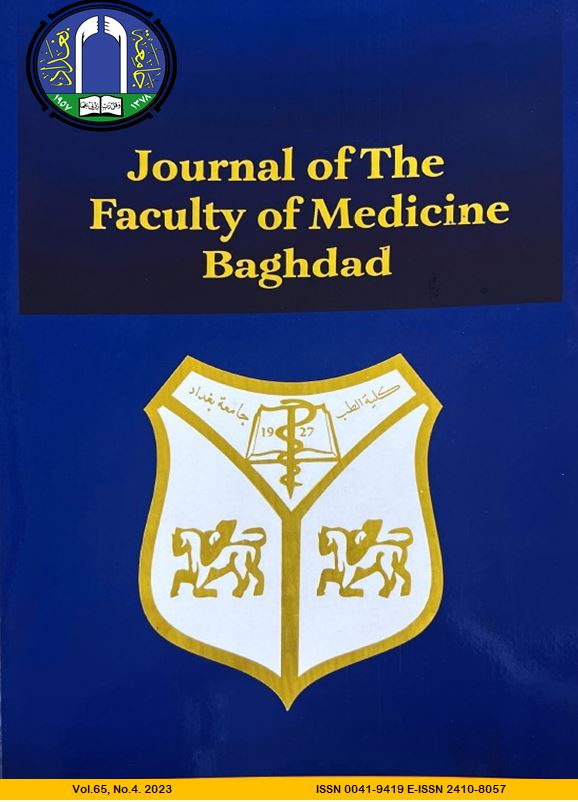The Impact of COVID-19 Infection on Gonadal Hormonal Functions in Iraqi Women
DOI:
https://doi.org/10.32007/jfacmedbagdad.1988Keywords:
COVID-19, Bleeding, Hormones, Gonads, PremenopausalAbstract
Background: The COVID-19 pandemic has had effects beyond the respiratory system, impacting health and quality of life. Stress related to the pandemic has led to temporary menstrual pattern changes in around one-third of women. These changes, likely driven by stress and anxiety, can result in problematic heavy bleeding, causing anemia and negatively affecting women's well-being. This also places a substantial socioeconomic burden on individuals, families, healthcare, and society.
Objectives: This study examined the impact of COVID-19 infection on the hormone levels (estradiol, prolactin, follicle-stimulating hormone, and luteinizing hormone) and heavy menstrual bleeding in Iraqi premenopausal women infected for at least four months.
Methods: This case-control study was conducted from November 2021 to April 2022, involving 100 married women aged 18 to 40. Participants were divided into two groups: 50 women with heavy bleeding post-COVID-19 infection (infection duration of at least four months) and 50 non-infected women.
Results: Comparing the mean ± SD of the two groups showed that the LH levels were statistically highly significant in women who suffered heavy bleeding post-COVID-19 infection compared to non-COVID-19 women, with a p-value of 0.000. There was no statistically significant difference in FSH levels between the two groups. The PRL levels were significantly higher for women who suffered substantial bleeding following COVID-19 infection compared to non-COVID-19 women, with a p-value of 0.003. Moreover, the E2 was significantly higher in women who suffered excessive bleeding following COVID-19 infection than in non-infected women.
Conclusion: This study suggests that COVID-19 may temporarily disrupt menstrual patterns, possibly due to stress and anxiety affecting the hypothalamus-pituitary-ovary axis. This disruption can manifest as elevated levels of gonad hormones (LH, PRL, and E2) and, in some cases, lead to heavy bleeding after a coronavirus infection.
Received Oct. 2022
Revised: Jan. 2023
Accepted Oct. 2023
Published Jan. 2024
Downloads
References
1. Alrefaee J, E Albalawi A, Alanazi S, A Althobaiti N, Daghash H, Abu Hasb T, et al. The predicting factors of clinical outcomes in patients with COVID-19 in the Kingdom of Saudi Arabia [KSA]: A multi-center cohort study. J Fac Med Baghdad. 2022 Jul 24;64(2):65-73. https://doi.org/10.32007/jfacmedbagdad.6421907.
2. Winters U, Ghosh M. Heavy menstrual bleeding management during the Covid pandemic. Obstet Gynaecol Reprod Med. 2021 Feb;31(2):53-58. doi: 10.1016/j.ogrm.2020.12.002. Epub 2021 Jan 8. https://doi.org/10.1016/j.ogrm.2020.12.002.
3. Bhattacharya S. Hysterectomy, endometrial ablation and Mirena(R) for heavy menstrual bleeding: a systematic review of clinical effectiveness and cost-effectiveness analysis. Health Technol Assess. 2011;15. https://doi.org/10.3310/hta15190.
4. Ikechebelu JI. Prevalence of gynaecological diseases in Nnewi, Nigeria. Niger J Clin Pract. 2005;8(2):1367. https://pubmed.ncbi.nlm.nih.gov/16477872/.
5. Khanehzad M, Abbaszadeh R, Holakuyee M, Modarressi MH, Nourashrafeddin SM. FSH regulates RA signaling to commit spermatogonia into differentiation pathway and meiosis. Reproductive Biology and Endocrinology. 2021; 19(1):1-19. https://doi.org/10.1186/s12958-020-00686-w.
6. Bosch E, Alviggi C, Lispi M, Conforti A, Hanyaloglu AC, Chuderland D, et al. Reduced FSH and LH action: implications for medically assisted reproduction. Human Reproduction. 2021;36(6):1469-80. https://doi.org/10.1093/humrep/deab065.
7. Jara LJ, López-Zamora B, Ordoñez-González I, Galaviz-Sánchez MF, Gutierrez-Melgarejo CI, Saavedra MÁ, et al. The immune-neuroendocrine system in COVID-19, advanced age and rheumatic diseases. Autoimmun Rev. 2021; 20(11):102946. https://doi.org/10.1016/j.autrev.2021.102946.
8. Du Y, Sheng H, Astruc D, Zhu M. Atomically precise noble metal nanoclusters as efficient catalysts: a bridge between structure and properties. Chem Rev. 2019; 120(2):526-622. https://doi.org/10.1021/acs.chemrev.8b00726.
9. Osayande AS, Mehulic S. Diagnosis and initial management of dysmenorrhea. Am Fam Physician. 2014; 89(5):341-6. https://doi.org/10.1136/bmj.332.7550.1134.
10. Mohammed IA, Ali AH, al shenaty JN. Clinical course and disease outcomes in hospitalized patients with 2019 novel corona virus disease at Ibn- Al Khateeb Hospital in Baghdad, Iraq. J Fac Med Baghdad. 2020 Nov 8; 62(3). https://doi.org/10.32007/jfacmedbagdad.6231775
11. Lundholm MD, Poku C, Emanuele N, Emanuele MA, Lopez N. SARS-CoV-2 (COVID-19) and the endocrine system. J Endocr Soc. 2020;4(11):bvaa144. https://doi.org/10.1210/jendso/bvaa144.
12. Sharp GC, Fraser A, Sawyer G, Kountourides G, Easey KE, Ford G, et al. The COVID-19 pandemic and the menstrual cycle: research gaps and opportunities. Int J Epidemiol. 2022 Jun 13; 51(3):691-700.https://doi.org/10.1093/ije/dyab239.
13. Mayo JL. A healthy menstrual cycle. Clin Nutr Insights. 1997; 5(9):1-8. https://acudoc.com/Healthy%20Cycle.PDF.
14. Brodin P. Immune determinants of COVID-19 disease presentation and severity. Nat Med [Internet]. 2021; 27. https://doi.org/10.1038/s41591-020-01202-8.
15. Teuwen LA, Geldhof V, Pasut A, Carmeliet P. COVID-19: the vasculature unleashed. Nat Rev Immunol. 2020; 20. https://doi.org/10.1038/s41577-020-0343-0.
16. Chadchan SB, Popli P, Maurya VK, Kommagani R. The SARS-CoV-2 receptor, angiotensin-convertin enzyme 2, is required for human endometrial stromal cell decidualization. Biol Reprod. 2021; 104. https://doi.org/10.1093/biolre/ioaa211.
17. Barbieri RL, Makris A, Ryan KJ. Effects of insulin on steroidogenesis in cultured porcine ovarian theca. Fertil Steril. 1983; 40. https://doi.org/10.1016/S0015-0282(16)47243-2.
18. Seif MW, Diamond K, Nickkho-Amiry M. Obesity and menstrual disorders. Best Pract Res Clin Obstet Gynaecol. 2015; 29. https://doi.org/10.1016/j.bpobgyn.2014.10.010.
19. Shakoor H, Feehan J, Mikkelsen K, al Dhaheri AS, Ali HI, Platat C, et al. Be well: A potential role for vitamin B in COVID-19. Maturitas. 2021; 144: 108-11. https://doi.org/10.1016/j.maturitas.2020.08.007.
20. Luck MR, Jeyaseelan I, Scholes RA. Ascorbic acid and fertility. Biol Reprod. 1995 Feb; 52(2):262-6. https://doi.org/10.1095/biolreprod52.2.262.
21. Bancroft J. The menstrual cycle and the well-being of women. Soc Sci Med. 1995 Sep;41(6):785-91. https://doi.org/10.1016/0277-9536(95)00045-9.
22. Al-Katib SR, Al-Kaabi MMH, Al-Safi WG, Al- Bderi AJ. Effect of the relationship between vitamin C and serum ferritin on fertility. Al-Kufa University Journal for Biology. 2018; 10 (1). https://doi.org/10.36320/ajb/v10.i1.8207.
Downloads
Published
Issue
Section
License
Copyright (c) 2023 Shatha M. Kadhum, Nawar S. Mohammed

This work is licensed under a Creative Commons Attribution 4.0 International License.












 Creative Commons Attribution 4.0 International license..
Creative Commons Attribution 4.0 International license..


